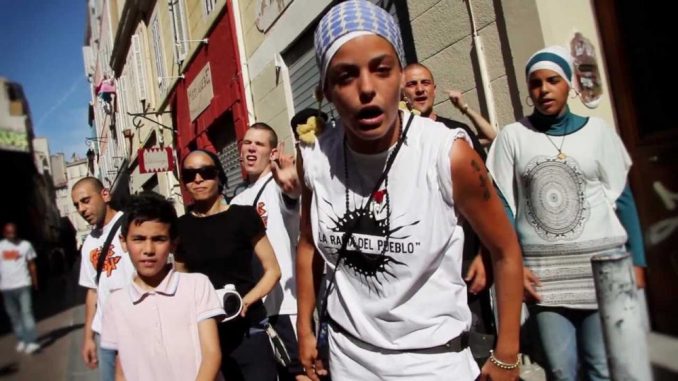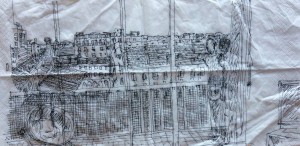
A commentary written by the Italian planners Rossella Marchini and Antonello Sotgia during a visit in Marseille, shared in Facebook on August 11, 2016.
Here we are in Marseille. After some years. We thought that this time we shouldn’t settle accounts with the cités (the big residential estates built in the 70s, and inhabited by the immigrants attracted by the city’s economic development). For us, to “settle accounts” with an urban area means to start walking. Going there and back again. With a reciprocal rule of employment: “no photos, nor debates on what we are seeing” (our debates are very lively, and those who see us get somewhat worried). This time we didn’t have Izzo to guide us; we already saw the cités, we were guided by him. Les cités? “You have to live there, or have been born there, or be an educator, to enter those neighborhoods”.  We already entered them. Now we wanted to see the results of the project Euromediterranée, that, linked to Marseille 2013 European capital of culture, aimed to connect the two great urban areas North and South, through an ambitious project that costed over 3,5 billion euros, and that transformed 480 hectars. Dated 1995-2020. What happened, and what is happening, around the construction of the new system of museums on the waterfront? Can we simplify it by using the word gentrification? The term can convey the idea, but only partially; because if you walk, and speak with people, while looking around (it might not be a scientific method, but it’s useful to us), you realize that now the city hasn’t got any longer two spaces separated by the deep carving of its port. Now, the long stretched hand with which the Greek dug the territory, has an appendix: a new center. The spatial union created a new addition. New foundations, aimed at cultural consumption. Until here, nothing new. What is new is who is supposed to use these new facilities: the passengers of cruising ships. Now, after they visit the museum over water, the castle that during the Revolution served as a prison, after touring towards Notre Dame de la Garde, they have access to a huge commercial system made of two elements. The big road, excavated in the channel of the docks, hosts shops and cafés, and on the first floor luxury houses, hotels and offices. A great concentration of single-brand shops and huge malls. A long promenade that ends on a (how could we do without?) skyscraper by Zaha Hadid, the headquarters of the powerful Port Authority. Is this all? No, because all around the new project, there are masses of new buildings, houses, some higher, some lower. The old streets disappeared, and with them the multitude of low self-built houses, in Provencal style, where thousands of families lived. They were displaced, and relocated into – and we return to the starting point – the cités. But this is not the Game of the Goose. Even here, somebody calls it “urban renewal”. You don’t need to be born there, to enter those neighborhoods: you can enter also if the lords of finance and real estate evaluate that your life is surplus, and send you to the garbage dump of housing. Marseille, the capital of culture“.
We already entered them. Now we wanted to see the results of the project Euromediterranée, that, linked to Marseille 2013 European capital of culture, aimed to connect the two great urban areas North and South, through an ambitious project that costed over 3,5 billion euros, and that transformed 480 hectars. Dated 1995-2020. What happened, and what is happening, around the construction of the new system of museums on the waterfront? Can we simplify it by using the word gentrification? The term can convey the idea, but only partially; because if you walk, and speak with people, while looking around (it might not be a scientific method, but it’s useful to us), you realize that now the city hasn’t got any longer two spaces separated by the deep carving of its port. Now, the long stretched hand with which the Greek dug the territory, has an appendix: a new center. The spatial union created a new addition. New foundations, aimed at cultural consumption. Until here, nothing new. What is new is who is supposed to use these new facilities: the passengers of cruising ships. Now, after they visit the museum over water, the castle that during the Revolution served as a prison, after touring towards Notre Dame de la Garde, they have access to a huge commercial system made of two elements. The big road, excavated in the channel of the docks, hosts shops and cafés, and on the first floor luxury houses, hotels and offices. A great concentration of single-brand shops and huge malls. A long promenade that ends on a (how could we do without?) skyscraper by Zaha Hadid, the headquarters of the powerful Port Authority. Is this all? No, because all around the new project, there are masses of new buildings, houses, some higher, some lower. The old streets disappeared, and with them the multitude of low self-built houses, in Provencal style, where thousands of families lived. They were displaced, and relocated into – and we return to the starting point – the cités. But this is not the Game of the Goose. Even here, somebody calls it “urban renewal”. You don’t need to be born there, to enter those neighborhoods: you can enter also if the lords of finance and real estate evaluate that your life is surplus, and send you to the garbage dump of housing. Marseille, the capital of culture“.
- Keny ARKANA (2013) Marseille capital de la rupture [official clip][mini-docu]
- Jean-Pierre GARNIER (2013) “Marsella 2013: el urbanismo como arma de destrucción masiva” [article in PDF].
- Alessi DELL’UMBRIA (2006) Histoire universelle de Marseille, de l’an mil à l’an deux mille, Agone. [book]
- Robert GUEDIGUIAN (2001) La ville est tranquille [link to the movie]
- Jean-Claude IZZO (1990) Chourmo. [novel, in PDF]
- Walter BENJAMIN (1928) Hashish en Marsella [english PDF][italian text][spanish commentary]
- Daniela DE DOMINICI, “Marsiglia icona di modernità urbana?“, unclosed.eu.